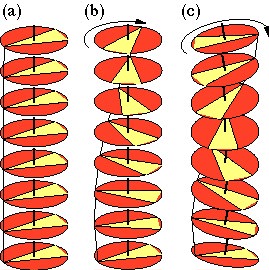Critical Velocity in Superfluid 3He-A
 The order parameter of superfluid 3He-A can be illustrated by a disc. The axis of the disc represents the orbital anisotropy direction l. The disc is marked so that the rotation around the axis is visible. In the equilibrium state of the superfluid, all discs are aligned, as illustrated in figure (a). (We can imagine as if the discs were connected by rubber strings.) A gradient in the rotation angle can be created if the discs at one end of our imaginary sample were rotated relative to the other end (b). The superfluid flows along our sample at a velocity directly proportional to the gradient. At a first critical velocity, the uniform orientation of l becomes unstable to a helical deformation (c). The helix is stable until a second critical velocity (not shown). At the latter instability, the l vector sweeps through large angles, which leads to formation of vortices.
The order parameter of superfluid 3He-A can be illustrated by a disc. The axis of the disc represents the orbital anisotropy direction l. The disc is marked so that the rotation around the axis is visible. In the equilibrium state of the superfluid, all discs are aligned, as illustrated in figure (a). (We can imagine as if the discs were connected by rubber strings.) A gradient in the rotation angle can be created if the discs at one end of our imaginary sample were rotated relative to the other end (b). The superfluid flows along our sample at a velocity directly proportional to the gradient. At a first critical velocity, the uniform orientation of l becomes unstable to a helical deformation (c). The helix is stable until a second critical velocity (not shown). At the latter instability, the l vector sweeps through large angles, which leads to formation of vortices.
We have calculated the critical velocities using hydrodynamic theory of
3He-A. As a first thing the stability of the superflow was studied
using one-dimensional model [1,2]. Recently, we have generalized the
calculations to two-dimensional case [3].
The results are in agreement with NMR experiments.
The accuracy of the predicted critical velocity in 3He-A
is better than in any other superfluid.
Publications
- V.M.H. Ruutu, J. Kopu, M. Krusius, Ü. Parts, B. Placais,
E.V. Thuneberg, and Wen Xu: Critical velocity in rotating superfluid
3He-A,
Phys. Rev. Lett. 79, 5058-5061 (1997),
cond-mat 9708226.
- J. Kopu, R. Hänninen, and E.V. Thuneberg:
One-dimensional textures and critical velocity in superfluid
3He-A,
Phys. Rev. B 62, 12374-12380 (2000),
cond-mat 0003210.
- J. Kopu and E.V. Thuneberg:
Soliton-limited superflow in 3He-A between parallel
plates,
J. Low Temp. Phys. 124, 147-162 (2001),
cond-mat 0101408.
Back to helium theory page
9.8.2001, Erkki Thuneberg,
Email
 The order parameter of superfluid 3He-A can be illustrated by a disc. The axis of the disc represents the orbital anisotropy direction l. The disc is marked so that the rotation around the axis is visible. In the equilibrium state of the superfluid, all discs are aligned, as illustrated in figure (a). (We can imagine as if the discs were connected by rubber strings.) A gradient in the rotation angle can be created if the discs at one end of our imaginary sample were rotated relative to the other end (b). The superfluid flows along our sample at a velocity directly proportional to the gradient. At a first critical velocity, the uniform orientation of l becomes unstable to a helical deformation (c). The helix is stable until a second critical velocity (not shown). At the latter instability, the l vector sweeps through large angles, which leads to formation of vortices.
The order parameter of superfluid 3He-A can be illustrated by a disc. The axis of the disc represents the orbital anisotropy direction l. The disc is marked so that the rotation around the axis is visible. In the equilibrium state of the superfluid, all discs are aligned, as illustrated in figure (a). (We can imagine as if the discs were connected by rubber strings.) A gradient in the rotation angle can be created if the discs at one end of our imaginary sample were rotated relative to the other end (b). The superfluid flows along our sample at a velocity directly proportional to the gradient. At a first critical velocity, the uniform orientation of l becomes unstable to a helical deformation (c). The helix is stable until a second critical velocity (not shown). At the latter instability, the l vector sweeps through large angles, which leads to formation of vortices.